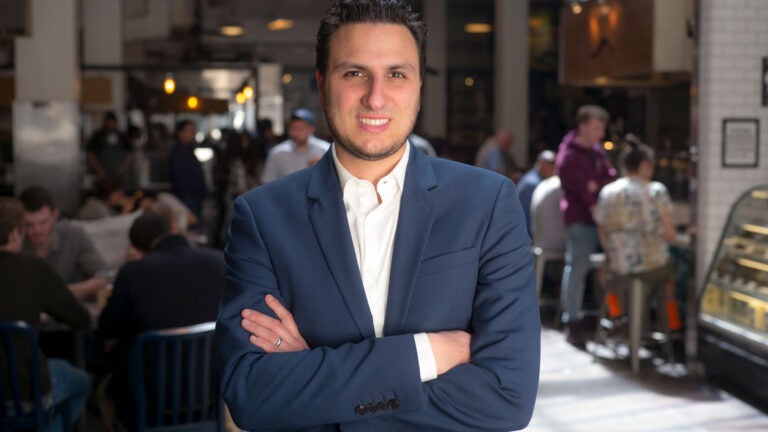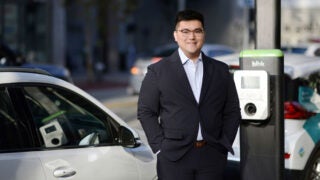
Trojan has a grand vision for L.A.’s historic Grand Central Market
Adam Daneshgar, 34, says the iconic food hall showcases the city’s cultural diversity, and he wants “to keep that value instilled going forward”
In his first job out of college, Adam Daneshgar worked atop Bunker Hill in downtown Los Angeles as a financial consultant for a real estate company. Frequently, he would trek down the stairs along Angels Flight and cross the street to Grand Central Market to enjoy one of his favorite lunches at an Argentine eatery that specialized in empanadas.
Three years ago, Daneshgar was back in the area as founder and president of Langdon Street Capital. He stopped by the historic L.A. venue and couldn’t believe how much it had changed, with a slew of new food concepts bringing long lines and a broader demographic. He figured the transformation must have been the result of new ownership, and he couldn’t help but feeling like it was a missed opportunity.
When he later learned that the venue hadn’t changed hands, he put his sentiment toward Grand Central Market into a heartfelt letter to the owner. That’s how, at 34 years old, the graduate of the USC Price School of Public Policy’s Dollinger Master of Real Estate Development program came to acquire one of the most iconic sites in Los Angeles.
Owning a food-centric marketplace had always been one of my dream projects.
Adam Daneshgar
“Owning a food-centric marketplace had always been one of my dream projects,” Daneshgar said. “I love being social, being out and about, and being around people. And I love to eat. Working in real estate, if I could have owned one project, it would have been Grand Central Market.”
Finding opportunity in the face of challenge
Daneshgar completed his MRED degree in 2009, a very difficult time in the real estate field amid the recession. He had hoped to land a job with a major developer of mixed-use projects, but seemingly no one was hiring. Development had stalled. A lack of options led him to start his own company to take advantage of properties that had become distressed due to the downturn.
It took until 2011 for him to make his first deal, a 57-unit apartment complex in Las Vegas that was missing part of its roof and had its pool filled in with dirt and landscaping. Using investments from friends and family, he bought it for $1.5 million, renovated it and rented it out. After growing a portfolio in Las Vegas consisting of approximately a thousand units, he began selling the properties and transitioning the proceeds into L.A. properties, focusing on creative office projects in prime locations.
“When I first started acquiring, I didn’t necessarily have a passion for distressed real estate in Las Vegas,” Daneshgar said. “It was more of a means to an end, and it worked out well. In 2011, you couldn’t go wrong. Prices were down and there was nowhere for the market to go but up. I was able to establish myself, build equity with my investors and slowly transition into properties that I was more passionate about.”
Christian Redfearn, the Borstein Family Endowed Professor of Real Estate at USC Price, noted how it wasn’t quite as easy as Daneshgar makes it sound. Redfearn lauded his former student’s acumen and entrepreneurship.
“There were a lot of people who could have bought property in 2010 or 2011,” Redfearn said. “It took a lot of wherewithal and foresight to do it. Banks weren’t lending. Just putting a deal together was a skill. Adam put in the effort and had the chops to say, ‘prices are low, and I know they might go lower, but I can’t pass up getting in now.’ After things did turn around, he kept pressing forward when others were tapping the brakes because the recovery cycle was getting old.”
Foundation for success
When he entered the MRED program, Daneshgar intended to learn skills that he might bring to his family’s real estate company. His father and uncles founded 3D Investments, which has owned and operated retail centers, regional malls, apartment complexes, office buildings and hotels for nearly four decades. His younger brother, Andrew, has been working with him at Langdon, where he oversees new tenant attraction, branding and marketing strategies for Grand Central Market.
During his time as a USC Price student, Daneshgar spent a lot of time in and out of class working with Redfearn to hone his skills in underwriting valuations, in preparation to go out on his own.
“I had exposure to many aspects of real estate, but development and construction experience were lacking for me,” Daneshgar said. “In the MRED program, I learned the whole process A to Z, acquiring a piece of land, underwriting it appropriately, going through the entitlement process, the construction, sale, etc. Then I was able to implement those skills in the real world and continue to build upon them.”
True to L.A. roots
Ira Yellin bought Grand Central Market in 1985, seeing it as a centerpiece to downtown’s revival. After he died in 2002, his widow, Adele, brought his vision to fruition. It wasn’t openly on the market when Daneshgar wrote Adele the introductory letter. But she had seemingly achieved the vision that her late husband originally imagined, and Daneshgar felt that perhaps she would be open to selling to the right buyer, one who would carry on the legacy that she and Ira had established.
“Grand Central Market represents a connection to the roots of L.A.,” Daneshgar said. “There are so many different cultures in Los Angeles that are represented in one location. I wanted her to know that I recognized that, that I appreciated that, and that I intended to keep that value instilled in the market going forward.”
For Daneshgar, the timing also was perfect. He was selling property that would provide him with a portion of the capital required to purchase the asset, and anticipated shifts in the real estate market had him ready to focus his attention on a big project.
“I’ve transitioned my focus from being an aggressive acquirer of real estate to settling in over the next couple years and letting the market stabilize — interest rates are rising and asking prices exceed values,” Daneshgar said. “In consideration of this, I’ve positioned myself to stabilize and improve my existing portfolio, allowing me to oversee this property with the attention it demands over the next couple of years.”
The deal also included the historic 2,300-seat Million Dollar Theatre, opened by Sid Grauman in 1918, 121 apartment units, 22,000 square feet of office space and a 500-space parking lot.
Vision for the Grand Central Market’s future
Daneshgar has a grand vision for Grand Central Market, but plans only minor changes to the overall vibe that the venue offers. He wants to refinish and polish the floors, implement a concierge to be the face of the marketplace, strengthen efforts around merchandising and creating brand awareness, work with vendors to add a centralized delivery system so that customers can order from multiple spots at once, and activate the basement level for special events such as pop-ups, art exhibits, food demonstrations and cooking classes, among other things.
“The market is great as it is,” Daneshgar said. “The essence doesn’t need to be changed. It’s raw, it’s historic — but it could use a modest enhancement while maintaining its charm and roots to its history.”
The substantial development planned around Grand Central Market will play a bid role in its growth, according to Daneshgar. The proposed Angels Landing project across the street alone would add 500 hotel rooms, 400 apartments and 250 condos.
“There’s going to be a ton of new residential in the immediate area, and residents are going to create a high demand for dinner options,” Daneshgar said. “That’s going to help our engagement level in the evenings, when it tends to be a bit slower. I’m very excited about the future of the market.”



